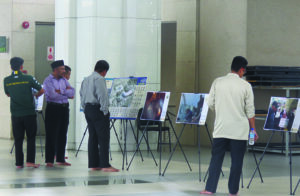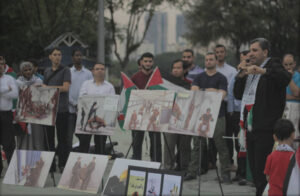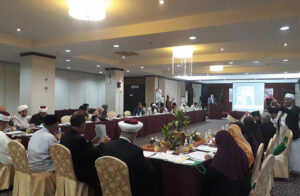The Palestinians in Occupied Palestine and the diaspora every year, on 30 March, commemorate the Land Day when Israeli forces in 1976 killed six Palestinians protesting against land confiscation in the Galilee.
Land Day has become an important event in the Palestinian collective narrative which emphasizes Palestinian resistance to Israeli colonization.
Land Day is usually marked with mass demonstrations and tree-planting campaigns in areas threatened with illegal confiscation in favor of Israeli settlement expansion.
In 2018, the Palestinians in the besieged Gaza Strip launched a major event to commemorate the Land Day called the Great March of Return (peaceful protests along the border between the Gaza Strip and the Palestinian territories occupied since 1948).
The spark
On 30 March 1976, massive protests broke out in the 1948 occupied Galilee over the Israeli government’s decision to seize about 21,000 dunums of Palestinian land in Arraba and Sakhnin villages in the Galilee.
Although there were also protests in the Naqab and Wadi Ara, in southern Palestine, most of the action took place in six villages in the Galilee that had been placed under curfew: Sakhnin, Arraba, Deir Hanna, Tur’an, Tamra and Kabul. The demonstrations were met with serious aggression and violence. Six Palestinians were killed and hundreds injured and arrested.
The Palestinian protests forced the Israeli government, which was led by Yitzhak Rabin then, to backtrack on the confiscation plan.
The first Land Day’s martyrs were Khair Yasin, 23, Khadija Shawahneh, 23, Raja Abu Rayya, 23, Khader Khalayla, 30, Mohsen Taha, 15, and Rafat Zuhdi, 21.
Develop the Galilee
In March 1976, the Israeli government unveiled a program to “develop the Galilee” by confiscating 21,000 dunums of Palestinian-owned land in favor of Jewish-only settlements. The program was seen by the Palestinians as a thinly-veiled attempt to Judaize the region.
The National Committee for the Defense of Arab Lands, which was formed a few years earlier, had been urging the government to stop its land expropriation plans since 1974. In response to the new declaration, they changed their tactics and called for a general strike to be held on 30 March.
Based on official statistics, the Israeli authorities between 1948 and 1972 confiscated over two million dunums of land in the Galilee and Triangle, a concentration of Arab towns and villages adjacent to the Green Line, added to millions of dunums of land seized during the 1948 Nakba.
Palestinians of 1948 territories
Land is at the heart of the conflict between the Israeli authorities and the Palestinians living in the territories occupied since 1948.
30 March 1976 was the first time that the Palestinians in the 1948 occupied territories had organized mass protests against Israeli policies.
About 1,700,000 Palestinians live in the Palestinian territories occupied since 1948 and they constitute 20% of the total population of Israel.
Historic Palestine
The total area of historic Palestine is about 27,700 square kilometers, Israeli Jews utilize more than 85% of it whilst Palestinians (the native inhabitants of the land) utilize less than 15% of the land, according to the Palestinian Central Bureau of Statistics.
44th Land Day
Because of the lockdown due to the coronavirus outbreak this year, the Palestinians, instead of organizing mass demonstrations to mark the 44th anniversary of the Land Day, decided to change the way they commemorate this special day.
Only a few number of Palestinians placed flowers at the graves of the Land Day martyrs in Sakhnin, Arraba, Tiba and Kafr Kanna after obtaining permits from the authorities. The rest of Palestinians took part by lighting candles, playing national songs and raising Palestine flags on their rooftops and balconies.
Settlement Expansion
The Palestinian Central Bureau of Statistics said in a recent report that by the end of 2018, the number of Israeli settlement outposts and military bases in the Occupied West Bank had reached 448.
The report noted that the number includes 150 settlements, 26 neighborhoods added to existing settlements, and 128 random settler outposts.
At the end of 2018, the number of Israeli settlers in the Occupied West Bank reached 671,007 with a population growth rate of about 2.7%.
This means that about 47% of the settlers live in Occupied Jerusalem. Their number is estimated at 311,462, including 228,614 living in the part that Israel annexed forcefully after its occupation of the West Bank in 1967.
The settler population in the Occupied West Bank is about 23 for every 100 Palestinians, while in Jerusalem it is 70 settlers for every 100 Palestinians.
Last year witnessed a concerning increase in the settlement expansion activity in the Occupied West Bank where the Israeli government approved the construction of 8,457 settlement units as well as 13 new settler outposts. Based on official statistics, the Israeli occupation in 2019 demolished 678 Palestinian buildings, 40% of whom were in Jerusalem. In the same year, the Palestinians received stop-construction orders for 556 new buildings in the West Bank.



